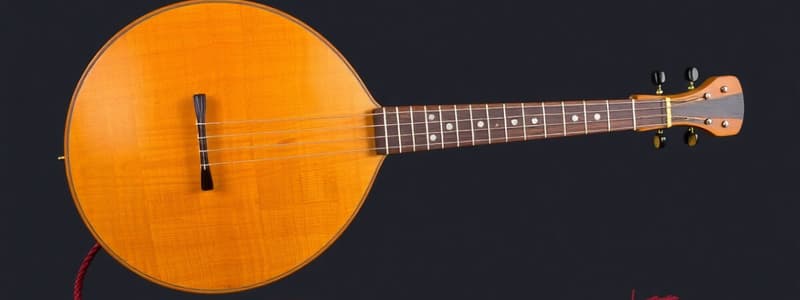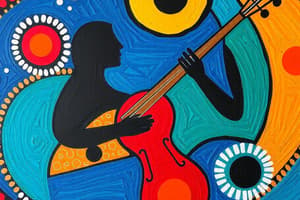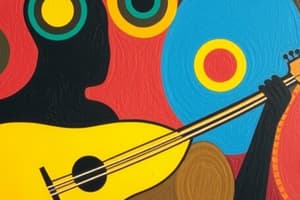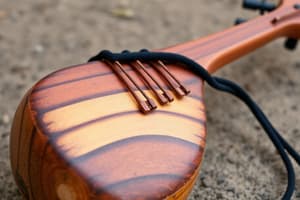Podcast
Questions and Answers
What is the primary material used for making a yidaki?
What is the primary material used for making a yidaki?
- Bamboo
- Acacia wood
- Pine wood
- Eucalyptus branch (correct)
What is the purpose of the wax or resin ring around the mouthpiece of a yidaki?
What is the purpose of the wax or resin ring around the mouthpiece of a yidaki?
- To help the instrument stay in place when playing
- To add ornamentation
- To enhance the instrument's sound quality
- To create a seal for the player's lips (correct)
Which of the following instruments is NOT traditionally used by First Nations Australians?
Which of the following instruments is NOT traditionally used by First Nations Australians?
- Clapsticks
- Seed rattle
- Saxophone (correct)
- Bull-roarer
What is the approximate range in length of a traditional yidaki?
What is the approximate range in length of a traditional yidaki?
Which of the following musicians is NOT a notable yidaki player?
Which of the following musicians is NOT a notable yidaki player?
How is playing the yidaki similar to playing a tuba or trombone?
How is playing the yidaki similar to playing a tuba or trombone?
Which of the following is NOT a traditional use of the yidaki?
Which of the following is NOT a traditional use of the yidaki?
How is a seed rattle typically constructed?
How is a seed rattle typically constructed?
What is the purpose of the bull-roarer?
What is the purpose of the bull-roarer?
Which of the following statements about traditional yidaki playing is TRUE?
Which of the following statements about traditional yidaki playing is TRUE?
Flashcards
Yidaki
Yidaki
A long musical instrument made from a hollow eucalyptus branch, used in ceremonies.
Playing technique
Playing technique
Players vibrate their lips against a wax seal while blowing, controlling airflow.
Traditional use
Traditional use
Used in First Nations Australian ceremonies, songs, and dances.
Clapsticks
Clapsticks
Signup and view all the flashcards
Bull-roarer
Bull-roarer
Signup and view all the flashcards
Seed rattle
Seed rattle
Signup and view all the flashcards
Drum
Drum
Signup and view all the flashcards
Gumleaf
Gumleaf
Signup and view all the flashcards
Famous players
Famous players
Signup and view all the flashcards
Yidaki history
Yidaki history
Signup and view all the flashcards
Study Notes
Yidaki
- Originated over 2,000 years ago by First Nations Australians
- Made from hollowed-out eucalyptus wood
- Used in ceremonies, songs, and dances
- Traditionally played by men
Yidaki Characteristics
- Length: 4-5 ft (1.2-1.5 m) to 10 ft (3 m)
- Hollowed-out branch
- Smooth wax or resin ring around mouthpiece
- Decorated with paint, burn marks, or carvings
Yidaki Playing
- Similar to a tuba or trombone
- Lips placed against mouthpiece
- Air blown through tube to create a low-pitched tone
- Players can create different noises, mimicking animal sounds.
Other Instruments
- Clapsticks: Two sticks clapped together, often used with Yidaki to accompany songs and dances
- Bull-Roarer: Leaf-shaped piece of wood attached to a cord, whirled to create a low-pitched roar
- Seed rattles: Made from dried seeds of plants, used for accompaniment to singing and dancing.
- Drums: Made of hollowed-out logs of eucalyptus trees, with skins of lizards, snakes, or kangaroos
- Gumleaf: Simple eucalyptus leaf instrument played by blowing against lips.
Studying That Suits You
Use AI to generate personalized quizzes and flashcards to suit your learning preferences.




